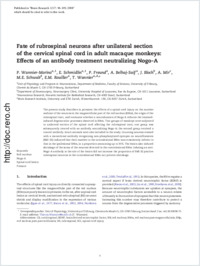Fate of rubrospinal neurons after unilateral section of the cervical spinal cord in adult macaque monkeys: Effects of an antibody treatment neutralizing Nogo-A
- Wannier-Morino, Patrizia Unit of Physiology and Program in Neurosciences, Department of Medicine, Faculty of Sciences, University of Fribourg, Switzerland
- Schmidlin, Eric Unit of Physiology and Program in Neurosciences, Department of Medicine, Faculty of Sciences, University of Fribourg, Switzerland
- Freund, Patrick Unit of Physiology and Program in Neurosciences, Department of Medicine, Faculty of Sciences, University of Fribourg, Switzerland
- Belhaj-Saïf, Abderraouf Unit of Physiology and Program in Neurosciences, Department of Medicine, Faculty of Sciences, University of Fribourg, Switzerland
- Bloch, Jocelyne Department of Neurosurgery, Neurosurgery Clinic, University Hospital of Lausanne, Switzerland
- Mir, Anis Neuroscience Research, Novartis Institute for BioMedical Research,Basel, Switzerland
- Schwab, Martin E. Brain Research Institute, University and ETH Zurich, Switzerland
- Rouiller, Eric M. Unit of Physiology and Program in Neurosciences, Department of Medicine, Faculty of Sciences, University of Fribourg, Switzerland
- Wannier, Thierry Unit of Physiology and Program in Neurosciences, Department of Medicine, Faculty of Sciences, University of Fribourg, Switzerland - Brain Research Institute, University and ETH Zurich, Switzerland
-
22.11.2007
Published in:
- Brain Research. - 2008, vol. 1217, p. 96-109
English
The present study describes in primates the effects of a spinal cord injury on the number and size of the neurons in the magnocellular part of the red nucleus (RNm), the origin of the rubrospinal tract, and evaluates whether a neutralization of Nogo-A reduces the lesioned-induced degenerative processes observed in RNm. Two groups of monkeys were subjected to unilateral section of the spinal cord affecting the rubrospinal tract; one group was subsequently treated with an antibody neutralizing Nogo-A; the second group received a control antibody. Intact animals were also included in the study. Counting neurons stained with a monoclonal antibody recognizing non-phosphorylated epitopes on neurofilaments (SMI-32) indicated that their number in the contralesional RNm was consistently inferior to that in the ipsilesional RNm, in a proportion amounting up to 35%. The lesion also induced shrinkage of the soma of the neurons detected in the contralesional RNm. Infusing an anti-Nogo-A antibody at the site of the lesion did not increase the proportion of SMI-32 positive rubrospinal neurons in the contralesional RNm nor prevent shrinkage.
- Faculty
- Faculté des sciences et de médecine
- Department
- Département de Médecine
- Language
-
- English
- Classification
- Biological sciences
- License
-
License undefined
- Identifiers
-
- RERO DOC 10581
- DOI 10.1016/j.brainres.2007.11.019
- Persistent URL
- https://folia.unifr.ch/unifr/documents/300768
Statistics
Document views: 164
File downloads:
- pdf: 249
